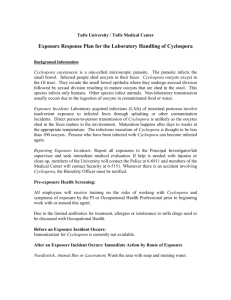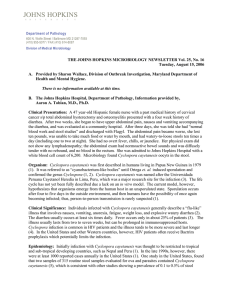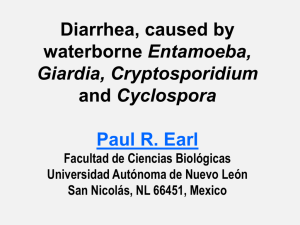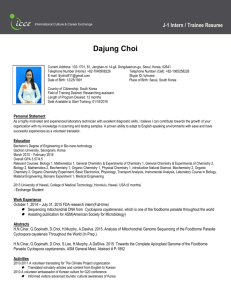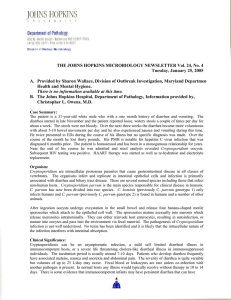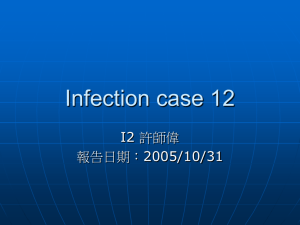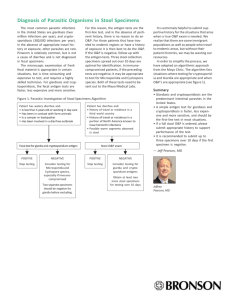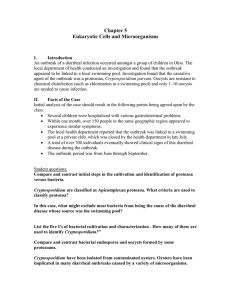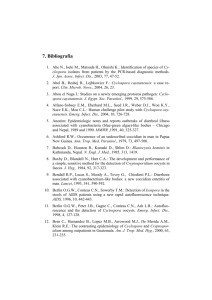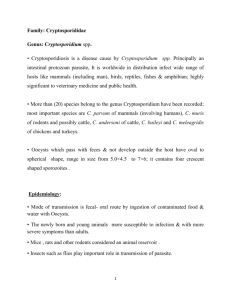THE JOHNS HOPKINS MICROBIOLOGY NEWSLETTER Vol. 24, No. 19
advertisement
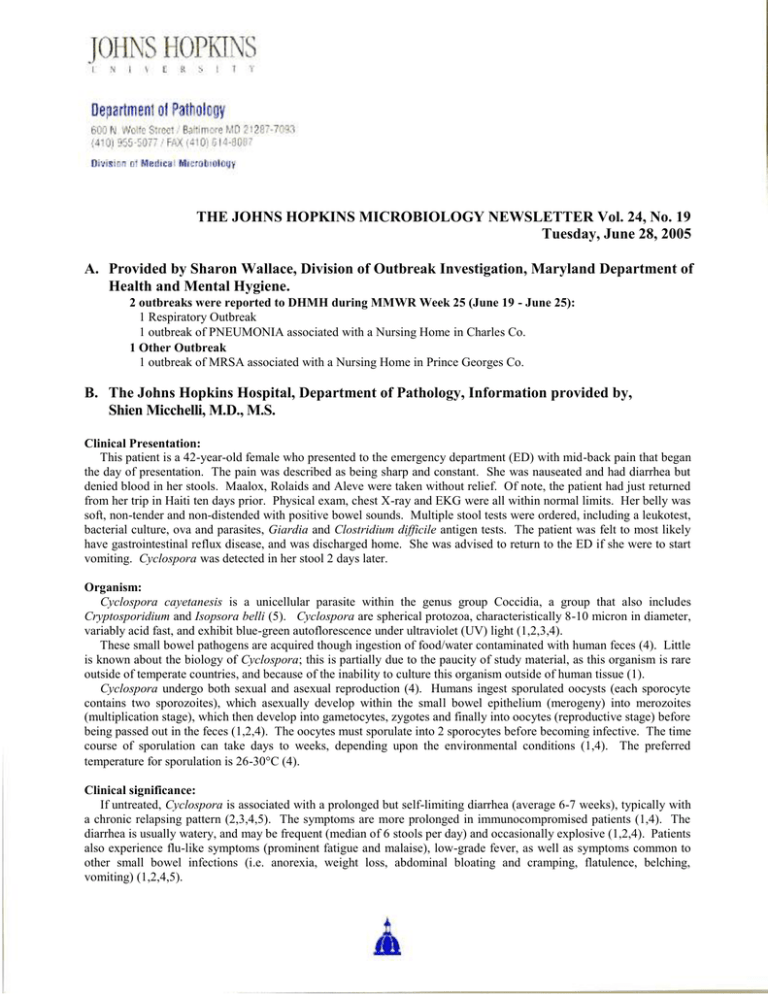
THE JOHNS HOPKINS MICROBIOLOGY NEWSLETTER Vol. 24, No. 19 Tuesday, June 28, 2005 A. Provided by Sharon Wallace, Division of Outbreak Investigation, Maryland Department of Health and Mental Hygiene. 2 outbreaks were reported to DHMH during MMWR Week 25 (June 19 - June 25): 1 Respiratory Outbreak 1 outbreak of PNEUMONIA associated with a Nursing Home in Charles Co. 1 Other Outbreak 1 outbreak of MRSA associated with a Nursing Home in Prince Georges Co. B. The Johns Hopkins Hospital, Department of Pathology, Information provided by, Shien Micchelli, M.D., M.S. Clinical Presentation: This patient is a 42-year-old female who presented to the emergency department (ED) with mid-back pain that began the day of presentation. The pain was described as being sharp and constant. She was nauseated and had diarrhea but denied blood in her stools. Maalox, Rolaids and Aleve were taken without relief. Of note, the patient had just returned from her trip in Haiti ten days prior. Physical exam, chest X-ray and EKG were all within normal limits. Her belly was soft, non-tender and non-distended with positive bowel sounds. Multiple stool tests were ordered, including a leukotest, bacterial culture, ova and parasites, Giardia and Clostridium difficile antigen tests. The patient was felt to most likely have gastrointestinal reflux disease, and was discharged home. She was advised to return to the ED if she were to start vomiting. Cyclospora was detected in her stool 2 days later. Organism: Cyclospora cayetanesis is a unicellular parasite within the genus group Coccidia, a group that also includes Cryptosporidium and Isopsora belli (5). Cyclospora are spherical protozoa, characteristically 8-10 micron in diameter, variably acid fast, and exhibit blue-green autoflorescence under ultraviolet (UV) light (1,2,3,4). These small bowel pathogens are acquired though ingestion of food/water contaminated with human feces (4). Little is known about the biology of Cyclospora; this is partially due to the paucity of study material, as this organism is rare outside of temperate countries, and because of the inability to culture this organism outside of human tissue (1). Cyclospora undergo both sexual and asexual reproduction (4). Humans ingest sporulated oocysts (each sporocyte contains two sporozoites), which asexually develop within the small bowel epithelium (merogeny) into merozoites (multiplication stage), which then develop into gametocytes, zygotes and finally into oocytes (reproductive stage) before being passed out in the feces (1,2,4). The oocytes must sporulate into 2 sporocytes before becoming infective. The time course of sporulation can take days to weeks, depending upon the environmental conditions (1,4). The preferred temperature for sporulation is 26-30C (4). Clinical significance: If untreated, Cyclospora is associated with a prolonged but self-limiting diarrhea (average 6-7 weeks), typically with a chronic relapsing pattern (2,3,4,5). The symptoms are more prolonged in immunocompromised patients (1,4). The diarrhea is usually watery, and may be frequent (median of 6 stools per day) and occasionally explosive (1,2,4). Patients also experience flu-like symptoms (prominent fatigue and malaise), low-grade fever, as well as symptoms common to other small bowel infections (i.e. anorexia, weight loss, abdominal bloating and cramping, flatulence, belching, vomiting) (1,2,4,5). After exposure, the incubation period is usually 1-11 days (mean 7 days) (1,2,4). The onset of illness may be abrupt in as many as 30% of cases (4). After a few days, the acute symptoms may subside, which is then followed by a recurrence of symptoms in a waxing-waning pattern (61% of cases) (4). Other patients have a more persistent pattern of symptoms (4). Infections are more prolonged and severe in AIDS patient, and can infrequently involve the biliary tract system (1,4,5). Cyclospora infects the small bowel, and is typically concentrated in the jejunum. Endoscopically, the small bowel exhibits moderate-severe erythema, which histologically shows parasitiophorous vacuoles containing several developmental forms of parasites within the gut epithelium (1,2,4,5). Epidemiology: Cyclospora are being identified with increasing frequency in the United States in both immunocompromised and immunocompetent patients with chronic diarrhea (3). Prior to 1996, cyclosporiasis was an infection that was almost exclusively found in patients returning from tropical countries. Multiple outbreaks of cyclosporiasis in the United States and Canada beginning in May 1996, were eventually attributed to imported raspberries from Guatemala, and other imported fruits and vegetables contaminated with human feces (1). Cyclosporiasis is obtained primarily by ingestion of contaminated fruit, vegetables and water. Because the oocytes passed in the feces require several days of sporulation before they become infectious, direct person-toperson transmission is not common (1,2,4,5). People of all ages are at risk for infection, with people traveling or living in developing countries at greatest risk. Despite the recent increase in Cyclospora infection, the incidence of disease is still quite low in Europe and North America. Studies conducted in Europe and North America revealed the prevalence of disease to be 0.1% and 0.3-0.5%, respectively (1). Cyclosporiasis is endemic in Nepal, Haiti and Peru (1). Laboratory diagnosis: The diagnosis of Cyclospora is made microscopically, by identifying oocysts in the stool (2,5). Cyclospora oocysts are nonrefractile, double-walled spheres measuring 8-10 m in diameter. Cryptosporidium has a similar appearance, except it is half as large, measuring 4-6 m. Like Cryptosporidium, Cyclospora is variably acid fast, with some organisms resisting staining (1,2). Cyclospora can be distinguished from Cryptosporidium because it autofluoresces blue-green in the presence of a 330-365 nm ultraviolet filter (1,2,3,4,5). Conventional oocyte and parasite (O&P) studies (trichrome stains and wet mount) do not reliably demonstrate Cyclospora oocysts, and the diagnosis of Cyclospora is often missed (2). The diagnosis of Cyclospora requires a high index of clinical suspicion, so that the appropriate O&P studies may be ordered. Two special stains allow a more reliable diagnosis: a modified acid fast stain, which is the standard stain for Coccidian oocysts; and a modified safranin stain, which is a more reliable stain that is more rapid, and easy to perform (2). Since Cyclospora is excreted intermittently and in small numbers, a single negative stool specimen does not rule out the diagnosis of Cyclospora (2). Three or more specimens at 2 to 3 day intervals may be required for a diagnosis (2). In addition, the stool is concentrated to maximize the recovery of oocytes (2). A PCR-based test, which amplifies the Cyclospora 18S ribosomal RNA, has been developed. However, this test is not generally available (2,5). Treatment: Double strength trimethoprim-sulfamethoxazole (TMP-Sulfa) is the treatment of choice (1,2,4,5). Although not as affective, ciprofloxacin is an acceptable alternative in patients allergic to sulfa-drugs (4). Depending on the level of dehydration, supportive measures may be necessary (fluid management and electrolyte balance) (2,4,5). References: 1) Institute of Food Science &Technology, March 2003. Cyclospora. http://www.ifst.org/hottop39.htm 2) Centers for Disease Control, August 2004. Parasites and Health, Cyclosporiasis, http://www.dpd.cdc.gov/dpdx/Default.htm 3) Ortega, Y., et al. Cyclospora—A New Protozoan Pathogen of Humans. New England Journal of Medicine, May 6, 1993, 328(18), 1308-1312. 4) Shoff, W. & Berhman, A., September 2003. Cyclospora. Emedicine, http://www.emedicine.com/MED/topic3393.htm. 5) Weller, P. & Leder, K., 2005. Cyclospora Infections. Up to Date, www.uptodate.com.
